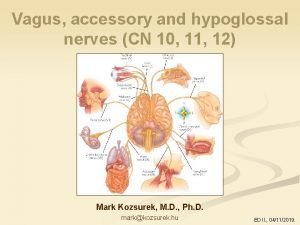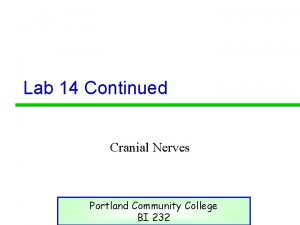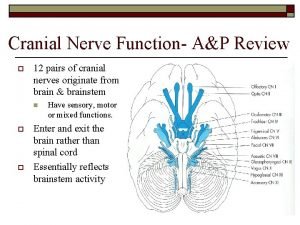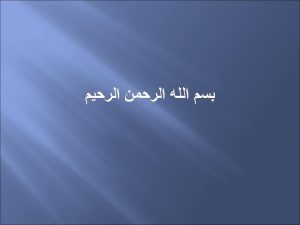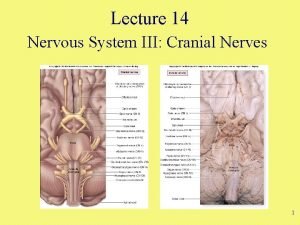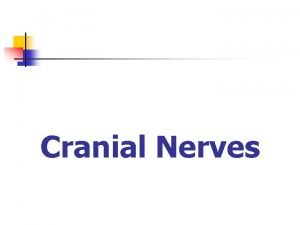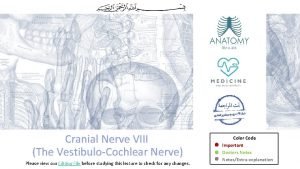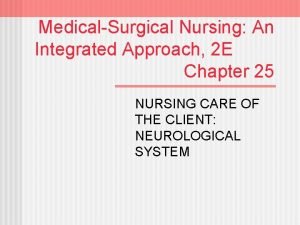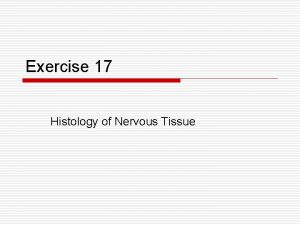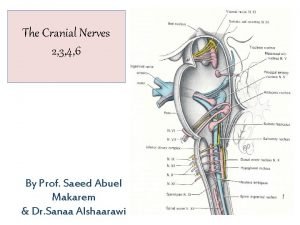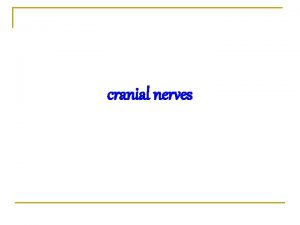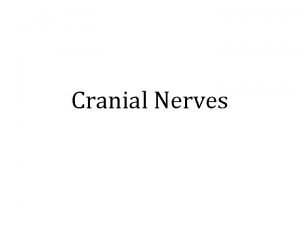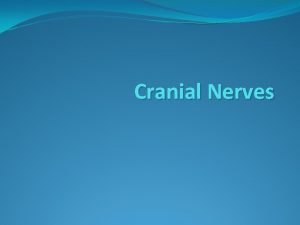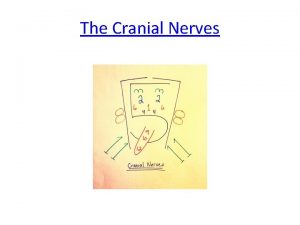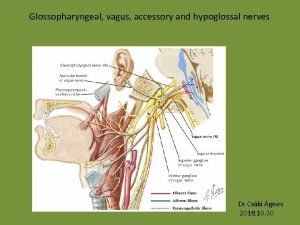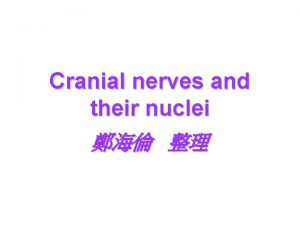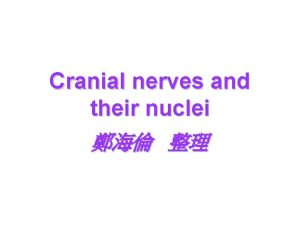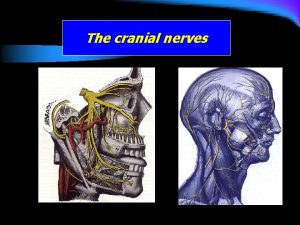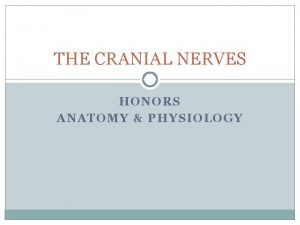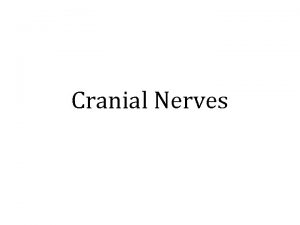The Cranial Nerves accessory and hypoglossal 11 th
















- Slides: 16

The Cranial Nerves accessory and hypoglossal (11 th & 12 th ) Dr. Jamela Elmedany Dr. Essam Eldin Salama

Objectives At the end of the lecture, the students should be able to: Ø List the nuclei related to accessory and hypoglossal nerves in the brain stem. Ø Describe the type and site of each nucleus. Ø Describe site of emergence and course of accessory and hypoglossal nerves. Ø Describe important relations of accessory and hypoglossal nerves in the neck. Ø List the branches of accessory and hypoglossal nerves. Ø Describe the main motor effects in case of lesion of accessory and hypoglossal nerves.

11 th CN: Accessory Nerve l l l Type: Motor Has two parts (roots): l Cranial part carries fibres that originate in the caudal part of nucleus ambiguus. l Spinal part arises from motor neurones in ventral horn of the spinal gray matter at levels C 1 -C 5 (spinal nucleus) Foramen of exit from skull: Jugular foramen

The Cranial Part l l Emerges from lateral aspect of the medulla between olive and inferior cerebellar peduncle, as a linear series of rootlets caudal to rootlets of the vagus nerve. At the side of medulla it joins the spinal root briefly It separates once again as the nerve leaves the cranial cavity through the Jugular foramen. At the level of jugular foramen these fibres join the vagus nerve and distribute with it to muscles of the soft plate, esophagus, pharynx and larynx

The Spinal Part l l The axons leave the cord via series of rootlets, emerge laterally midway between the dorsal and ventral roots of the spinal nerves. Courses rostrally and enter the cranial cavity through the foramen magnum, and joins the cranial root briefly Separate once again as the nerve leaves the cranial cavity through the Jugular foramen. Supplies the sternomastoid and trapezius muscles

The nucleus ambiguus and the spinal nucleus receive bilateral corticonuclear fibers (from both cerebral hemispheres)

Function: l l Movements of the soft palate, larynx, pharynx. Controls the movements of neck

Injury of the Spinal Root of Accessory Nerve l l l Causes: Because of the relatively superficial position of the nerve in the posterior triangle, it may be damaged by penetrating trauma as stab wounds. It is considered the most commonly iatrogenically injured nerve as during removal of malignant lymph nodes in the posterior triangle.

l l l Manifestations: It produces atrophy and weakness of trapezius. Unilateral paralysis of trapezius is evident by inability to elevate & retract the shoulder , difficulty in elevating the arm & Winging of scapula Dropping of the shoulder is an obvious sign of injury of the nerve. The lesion also causes difficulty in swallowing and speech& Inability to turn the head

12 th CN: Hypoglossal Nerve l l Type: Motor Origin: Hypoglossal nucleus of the medulla (in the floor of 4 th ventricle) The fibers emerge from the anterior surface of the medulla oblongata through the sulcus between the pyramid and the olive. Foramen of exit from skull: Hypoglossal canal Pyramid Olive

The hypoglossal nucleus receives corticonuclear fibers from both cerebral hemispheres EXCEPT the region that supplies genioglossus muscle (receives contralateral supply only) Also receives afferent fibers from nucleus solitarius and trigeminal sensory nucleus.

Course: l The nerve courses downward with cervical neurovascular bundle (internal carotid artery, internal Jugular vein, vagus nerve) l Then curves forward behind mandible to supply the tongue

During its initial course, it carries C 1 fibers which leave in a branch to take part in the formation of ansa cervicalis (a loop of nerves supplying neck muscles) C 1 fibers

l l Function: 1. Supplies motor innervation to all of the muscles of the tongue except the palatoglossus (which is supplied by the vagus nerve). So, it Controls the movements and shape of the tongue during speech and swallowing 2. Carries proprioceptive afferents from the tongue muscles.

l l Manifestations of Lesion of the nerve (LMN) : l Loss of tongue movements l Difficulty in chewing and speech l The tongue paralyses, atrophies, becomes shrunken and furrowed on the affected side (LMN paralysis) l On protrusion, tongue deviates to the affected side If both nerves are damaged, person can’t protrude tongue Normal Lesion left CN 12

 Cannon-böhm point
Cannon-böhm point Cranial nerves mixed sensory motor
Cranial nerves mixed sensory motor Cranial nerve for smile
Cranial nerve for smile Cranial accessory nerve supplies
Cranial accessory nerve supplies First and second cranial nerves
First and second cranial nerves Cranial nerve function mnemonic
Cranial nerve function mnemonic Cn v test
Cn v test First and second cranial nerves
First and second cranial nerves Cranial nerves sensory and motor
Cranial nerves sensory and motor Motor and sensory cranial nerves
Motor and sensory cranial nerves Brachioradialis reflex nerve root
Brachioradialis reflex nerve root Exercise 15 histology of nervous tissue
Exercise 15 histology of nervous tissue Optic chiasm
Optic chiasm Our old trusty truck cranial nerves
Our old trusty truck cranial nerves Optic nerve names
Optic nerve names Labeled
Labeled Cranial nerves
Cranial nerves
